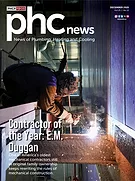Milwaukee Tool invited 23 media professionals to take a tour of its Sawzall blade facility in Greenwood, Mississippi last March.
Although the plant also makes the Hole Dozer hole saw, the big draw was viewing Greenwood’s Sawzall production since it is the only place in the world that makes the blades for the reciprocating saw Milwaukee Tool invented in 1951.
“We have an outside-in focus,” said Scott Griswold, president of the company’s power tool accessories group in his opening remarks, explaining the overall concept of what would be on view over the next few hours.
“Everything you will see starts with the user, comes back through the organization and ends up all the way to the shop floor,” he added.
And while the product churned out by the site’s 670 workers were the blades and hole saws — more than enough of the products made every year to place end-to-end upon the Earth’s equator — Griswold said that wasn’t really the business Milwaukee Tool’s ultimately in.
“It’s the cost per hole or cost per cut and not the cost per blade that’s critical,” Griswold said, “since the cost of labor is our customers’ biggest expense.”
Carbide teeth
That marketing philosophy was on display, in particular, with recent improvements made to the company’s latest addition to the Sawzall blade line — the Ax with Carbide Teeth. According the company, the blade promises to deliver 30 times longer life over regular bi-metal blades and two times faster cutting than other carbide blades.
Product Manager Brad Urban shared a brief history of the Ax blade, originally marketed in 1999 specifically for demolition. Milwaukee Tool improved the line with Variable TPI (teeth per inch) on the blade in 2002, plus added the Fang Tip and Nail Guard technology in 2012.
The Ax with Carbide Teeth blade came to market last year after the company made more than 1,500 different prototypes in order to develop this new line.
The company conducted blind testing with contractors, putting prototypes up against unmarked competitors’ recip blades. As a result of the tests, the company discovered that its contractor customers weren’t switching out the Milwaukee Tool blades no matter what material needed to be cut. The professionals were using the prototype, essentially a “wood” blade meant to cut through nail-embedded lumber, to also cut through just about anything else they might find on a jobsite, such rebar and black pipe.
Product managers put the blade prototype through further torture tests and found the blade could handle the following punishment:
- 300 cuts in hardened fasteners.
- 200 cuts in roofing material.
- 35 cuts and ½-inch rebar.
- 25 cuts into 1-inch schedule 40 black pipe.
- 20 cuts and ½-inch stainless steel.
The secret, of course, was in the carbide teeth. And the challenge, of course, was going from making a handful of custom-built prototypes to mass-manufacturing the blades.
“Our users are looking for a blade that is fast and durable,” Heath A. Nunnemacher, program manager told us after walking us through the manufacturing process.
That sounded simple enough to us. However, Nunnemacher said there’s often a trade-off between those two benefits.
A lower TPI, for example, allows the blade to cut faster through wood. But the extra space between the teeth gives any nails embedded in the wood the chance to break the teeth. More teeth per inch? That will make the blade more durable, but slow it way down.
Milwaukee Tool had already engineered some of these compromises into its BiMetal Ax blades. The Fang Tip design, for example, helps to bite and hang on to that first contact, whereas other brands might just skate across the surface.
The carbide teeth took the Ax family to the next level.
The process
The easiest part of the process was the choice of carbide, in this case, a compound of equal parts tungsten and carbon.
“Tungsten is Swedish for ‘heavy stone,’” Nunnemacher explained. “It is twice as stiff and double the density of steel.”
The addition of carbide is old news for circular saw blades, but a difficult proposition for manufacturing reliable recip blades.
“The cutting dynamics for a circular saw are very smooth,” Nunnemacher said. “But compare that with a recip saw in which the blade is likely to encounter interrupted cutting along with high shock patterns as it does its job.”
Nunnemacher aptly described the difference as a NASCAR driver racing around a concrete oval track versus a Rally car driver bouncing over hills and making quick turns on a natural, dirt track.
Also, carbide is typically brazed onto circular saw blades using some type of intermediary in much the same way that flux is used to braze a copper fitting. That approach wouldn’t work as far as Milwaukee Tool was concerned with recip blades. Other brands may use brazing for their recip blades, but Milwaukee Tool thinks those brands are inconsistent. One blade out of the pack might work like a charm, but the next blade could break upon first use.
The company’s engineering team went to work and after countless hours of R&D, found the best way to place the carbide was to weld — or this case fusion weld — each tiny bit of carbide to the blade’s individual teeth.
If we didn’t see the process itself we’d have a hard time believing it. Even after seeing the process, we still have a hard time understanding how the company engineered this feat. Keep in mind, the company wants to keep this a trade secret and walls off this portion of the factory behind towering partitions.
While we were allowed to take pictures, we weren’t allowed to film video or take pictures of the monitors above the welding stations that show the action close-up.
The best we can say is imagine a bit of carbide smaller than a grain of rice individually welded onto the teeth of the blade. Unlike the company’s other recip blades, these particular blades are ground into a partial tooth form. Basically, the carbide provides the tip.
All Nunenacher would say to describe the process was that the variables of “time, temperature and pressure” were the keys to forming a strong electro-mechanical bond between the two dissimilar metals.
Best of the rest
Once the carbide tip is welded on, these blades go through the same, washing, setting and powder-coating processes as standard Ax recip blades.
Our tour went from the start — where thousands of feet of raw material is unrolled and straightened before a press stamps out the blanks — to the finish — where the final products are packaged and ready to ship. In between the blades are ground, washed, set, heat-treated, powder-coated and logo-printed with a UV process that sets the ink in a second.
It’s easy to see how the processes are synched and employees stationed for maximum efficiency of the manufacturing process. While we saw plenty of automation, we also saw plenty of instances that require the human touch. And like the employees, the robots are clad in Milwaukee red.
In general, here are a couple of manufacturing highlights that Milwaukee Tool believes set its recip blades apart from competitors.
Grinding not milling the teeth: The company places the teeth on the blades only after the blade stock is stamped out. Other companies start with the teeth already in the stock.
Milwaukee Tool says making the teeth after stamping ensures a consistent pattern to the blade’s teeth.
Also, grinding the teeth into the blade rather than milling, provides further consistency. With milling, makers have a cutting tool that’s bound to degrade each and every time, making a cut a little worse than the last.
Milwaukee Tool also pointed out that its diamond-grinding wheel is redressed after each 3-inch stack of blades has run through.
Setting the teeth: Here’s a prime example of automation. After the grinding process, the blades go through a washer. Then, a robot grabs a 3-inch stack of blades and places them into one of four teeth-setting machines. Those machines offset each blade’s tooth left and then right so that the kerf of the cut exceeds the blade width. Without this process, material would quickly gum up the blade. The robots can keep within a quality control limit of 1/20,000 of an inch.
Small bath heat treatment: After the teeth have been set, the blades are heat treated in small batches. The company says that treating blades in large batches can produce temperature swings as much as 50 degrees. In this case, the small electric ovens that hold three trays of blades in a single layer can greatly minimize temperature differences.






